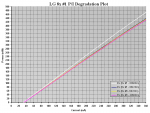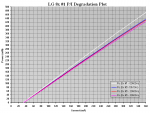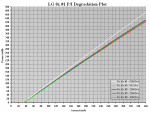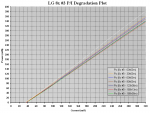Nearing 30h ON-Time with the second diode @348mA! :yh:
The old diode has crossed 10.000 cycles by now @300mA, waiting for 180h...
For those using this info to decide on a current setting, please keep in mind that power matters too, just as much as current.
Just because one low efficiency 8x survives 30h or more at 348mA, doesn't mean all higher efficiency ones will too (nor that they won't).
Some higher efficiency 8x's could degrade themselves faster at that current due to their higher optical flux. Others again can live longer, if they are tougher.
Also, this doesn't mean that all lower efficiency diodes will survive higher currents longer...
Unfortunatelly, there is no way to tell how tough any particular diode is.
For example, LG 8x #1 started out at approx the same power as my personal 8x, altho my personal 8x is at a lower current, and they both seem to degrade with approx the same speed during the first hours, possibly because of the similar power.
Otherwise i dug up some degradation info on an older 60mW 405nm diode...
This first chart shows how the tested diodes need more and more curent to maintain the same power as time elapses:
The second chart is a lifetime prediction chart. Every blue rectangle represents a "dead" diode and they were declared dead when Iop becomes 1.3 times that of initial current (the diode needs 30% more current than at the start to reach the same power):
Both charts show the murder of 15 60mW CW diodes similar (or identical?) to PHRs, but powered at their rated power.
As you can see in the first chart, every single one of them degrades even at their rated power and this is noticable even during the early hours. In fact there is a small bend in the lines of the first chart showing the current increase, indicating that degradation there might also be fastest at the start.
This is why i'm confused, when i see so many claims of no degradation with time at the high powers we are using.
One other thing the first chart shows is, that the diodes took 1200h to reach approx 10% of degradation.
The second chart shows that it then took a total of 5200h for them to become declared "dead", or required 30% more current to maintain the same power
on average (MTTF).
On average those diodes lived a total of 4.33 times as long as it took to reach the first 10% of degradation. Of course that doesn't mean anything for our diodes driven to much higher powers - they might not even reach the level of degradation where it would take 30% more current to maintain initial power.
In manufacturer's tests, the diodes are always driven at a constant power, in this case 60mW, while we drive them at a constant current.
The constant current part could further explain why degradation slows down so much in our case, while it seems
almost linear in the first chart - our diodes drop in power as they degrade, the lower optical flux degrades them at a slower rate...
4 more cycles till 30h re-plotting. :yh:
EDIT: Diodes succesfully reached 30 and 170h respectivelly. Cooling off for re-plotting.
EDIT:
... this behavior is how lasers age. The aging rate decreases as the laser "burns in". Here's an image from an OSRAM paper published last year on nitride laser aging (these were actually 450nm diodes, so there are some differences vs. the 405nm laser discussed here). But the point remains, this is typical laser diode behavior.
I'm assuming those tests took place at a constant power?
If it's typical there, where the current is constantly increasing as efficiency drops in order to maintain a power, it makes much more sense here, where the power drops as the diode degrades, while the current stays the same.












